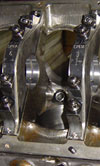Which hardening method is best?
 Last month we looked into induction hardening of crankshafts and the inherent differences between that process and nitriding.
Last month we looked into induction hardening of crankshafts and the inherent differences between that process and nitriding.
We saw that induction hardening carries significant potential benefits; the main one being that the crankshaft is only heated locally which means that distortion can be effectively managed.
There is also no maximum limit on case depth with induction hardening, which is potentially a benefit in terms of strength but also a potential risk. Any experienced crankshaft designer will be well aware of the risks of allowing a thin section to go through hard as this can lead to premature failure.
The disadvantages are that the process typically requires expensive bespoke tooling and that it only works well in steels with 0.4% carbon, although steels with a lower carbon content can be carburised prior to induction hardening.
This month we are looking into case hardening. Case hardening is normally used on plain carbon steels with no, or few, alloying elements which are therefore not suitable for hardening via the conventional quenching and tempering process.These steels, which might typically have a carbon content between 0.1% and 0.3% C, are also carburised prior to case hardening. Carburising is a diffusion based process wherein a component is packed in a carbon rich environment and subjected to heat over a period of time until the carbon content of the surface layer is sufficiently high for it to be hardenable.
The carburisation process can be as unsophisticated as flame heating the component and then quenching it in oil. The surface layer can then be hardened in the conventional manner, through being held at a given temperature for a given period of time before being quenched, so as to lock in micro-structural changes.
So let’s return to the original question from last month; which heat treatment process was specified for the straight eight 1930s grand prix crankshaft for which the author has modelled and produced a production drawing?
If the reader recalls, the crankshaft could not be nitrided due to the rolling element bearings used on the mains and crankpins, but the answer is that the crankshaft will be induction hardened. Induction hardening is ideally suited for such a relatively long (over one metre) crankshaft, as the potential for distortion in an ammonia furnace is immense.
Not that induction hardening will be a cheap way forward as five different inductors will be required due to the variety of journals to be hardened, but then scrapping a one metre long crankshaft at the heat treatment stage is not a cheap thing to do either!
As with everything in life practice makes perfect and the plan is to produce a test piece which will allow the induction hardeners to conduct trials on all five journal configurations to ensure that the settings are perfect for the actual crankshaft.
Induction hardening is not widely used in racing crankshafts – although practitioners are keen to point out that it is used – but it has a lot of potential benefits so the next time you are specifying heat treatment on a crankshaft it may pay to think twice.
Written by Tom Sharp.